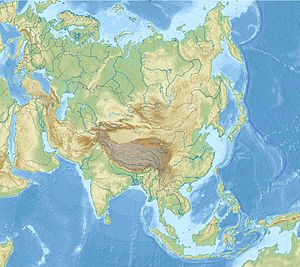Ghazni
غزنی | |
|---|---|
 Citadel of Ghazni, seen from Tapa Sardar. | |
| Coordinates: 33°32′57″N 68°25′24″E / 33.54917°N 68.42333°E | |
| Country | |
| Province | Ghazni Province |
| District | Ghazni District |
| Elevation | 2,219 m (7,280 ft) |
| Population (2021)[1] | |
• Total | 190,424 |
| Time zone | UTC+4:30 (AST) |
Ghazni (Dari: غزنی, Pashto: غزني), historically known as Ghaznayn (غزنين) or Ghazna (غزنه), also transliterated as Ghuznee, and anciently known as Alexandria in Opiana (Greek: Αλεξάνδρεια Ωπιανή),[2] is a city in southeastern Afghanistan[3] with a population of around 190,000 people.[1] The city is strategically located along Highway 1, which has served as the main road between Kabul and Kandahar for thousands of years. Situated on a plateau at 2,219 metres (7,280 ft) above sea level, the city is 150 kilometres (93 mi) south of Kabul and is the capital of Ghazni Province. The name Ghazni drives from the Persian word "ganj", meaning ‘treasure’.[4]
Ghazni Citadel, the Minarets of Ghazni, the Palace of Sultan Mas'ud III, and several other cultural heritage sites have brought travelers and archeologists to the city for centuries. During the pre-Islamic period, the area was inhabited by various tribes who practiced different religions including Zoroastrianism, Buddhism and Hinduism.[5][6] Arab Muslims introduced Islam to Ghazni in the 7th century and were followed in the 9th century by the Saffarids. Sabuktigin made Ghazni the capital of the Ghaznavid Empire in the 10th century. The city was destroyed by one of the Ghurid rulers but later rebuilt. It fell to several regional powers, including the Timurids and the Delhi Sultanate until it became part of the Hotaki dynasty, which was followed by the Durrani Empire or modern Afghanistan. During the First Anglo-Afghan War in the 19th century, the fortifications of Ghazni were partially demolished by British Indian forces.
In August 2018, the city became the site of the Battle of Ghazni with the Taliban briefly occupying it and taking control of most of the surrounding area. On 12 August 2021, the city was captured by the Taliban as part of the 2021 Taliban offensive.[7][8][9]
In 2013, ISESCO declared Ghazni the year's Islamic Capital of Culture.[10]
- ^ a b "Estimated Population of Afghanistan 2021-22" (PDF). National Statistic and Information Authority (NSIA). April 2021. Archived (PDF) from the original on June 24, 2021. Retrieved June 21, 2021.
- ^ The Princeton Encyclopedia of Classical Sites, ALEXANDRIAN FOUNDATIONS Iraq, Iran, Afghanistan, Soviet Central Asia, India
- ^ "ḠAZNĪ – Encyclopaedia Iranica". iranicaonline.org. Retrieved 2021-02-22.
- ^ Everett-Heath, John (2019-10-24). The Concise Oxford Dictionary of World Place Names. Oxford University Press. doi:10.1093/acref/9780191882913.001.0001. ISBN 978-0-19-188291-3.
- ^ Richards, J.F. (1974). "The Islamic frontier in the east: Expansion into South Asia". Journal of South Asian Studies. 4 (1): 91–109. doi:10.1080/00856407408730690.
- ^ Gnoli, Zoroaster’s Time and Homeland, pp. 26–39
- ^ "Taliban take strategic Ghazni city as Afghan army chief is replaced". The Guardian. 12 August 2021.
- ^ Varshalomidze, Tamila (12 August 2021). "Taliban captures Ghazni city, all government officials flee: Live". Al Jazeera English.
- ^ "Taliban move closer to capital after taking Ghazni city". France24. 12 August 2021. Retrieved 12 August 2021.
- ^ "Ghazni To Be Islamic Capital Of Culture". RadioFreeEurope/RadioLiberty. Retrieved 31 March 2018.


